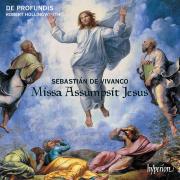Texte paru dans: / Appeared in: |
|
|
Outil de traduction ~ (Très approximatif) |
|
|
Reviewer: J.
F. Weber Sebastián de Vivanco (c. 1551–1622), born in Ávila, sang in the cathedral as a choirboy at the same time as Victoria. The choirmaster was Bernardino de Ribera, whose music made up the first recording of this vocal ensemble (Fanfare 40:2). He was maestro at the Lérida cathedral for three years, served at the Segovia cathedral for 10 years (he was ordained a priest at this time), then at Ávila in 1588, and finally at Salamanca cathedral in 1602. Three books of his works, Magnificats, Masses, and motets, were published there from 1607 to 1610. His Missa In manus tuas for eight voices, the sixth of 10, was recorded by Michael Noone (27:1); his Missa Beata Maria for four voices, the third in the book, by Elizabeth Patterson (29:2); and his Missa Crux fidelis for six voices, the fourth in the book, by David Trendell (29:3). The Mass for five voices on this disc is the first of the 10, already recorded with the related motet by Bruno Turner in 2001 on La mà de guido LMG 2045. Motets and Magnificats fill out all the discs except Patterson’s and are found on eight other discs in my collection. He was introduced to records by Alberto Blancafort about 1960, then by Bruno Turner in El Siglo de Oro in 1978 (2:3).
The conductor is known here as the leader of I Fagiolini, while the Ribera program introduced us to this newer ensemble under a different conductor. The Mass is based on the composer’s motet Assumpsit Jesus Petrum, which recounts the transfiguration, hence the disc includes three chant Propers for the feast of the Transfiguration, sung from the Medicean Edition (volume 2, 1615). His motet replaces the offertory of the Mass, and his motet O sacrum convivium is the right choice to replace the communion. The book of Magnificats consists of 16 alternatim settings in all eight modes, half set to the odd verses, the other half to the even verses (just as Palestrina had done). Added to these were a setting in mode 1 for six voices and a setting in mode 8 for eight voices; the last was once recorded by David Hill, the other is heard here. The book of motets survives with about 70 works, most of them never recorded.
This program ranks with Trendell’s disc as an example of Vivanco’s music. The Mass is faster in every movement than the version by Turner (who wrote the notes here). Both versions represent the Mass fairly, though Hollingworth has a choir of 25 men with a bajón (a dulcian, or early bassoon) accompanying, while Turner used eight mixed voices. Of the motets, Versa est in luctum (also set by Alonso Lobo and other Spanish composers) has been recorded by James O’Donnell, Noone, Trendell, and the King’s Singers; Veni, dilecti mi by Noone, Trendell, and Stile antico; Assumpta est Maria by Noone and Trendell. The other three motets seem to be first recordings. If you do not know Vivanco yet, this is an excellent place to become acquainted. | |
|
|
|
|
Cliquez l'un ou l'autre
bouton pour découvrir bien d'autres critiques de CD |
|




